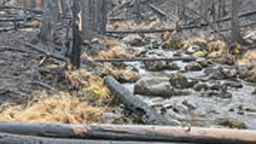New research from the U.S. Geological Survey links wildfires to increased mercury concentrations in Pacific Northwest headwater streams.
The findings document increases in total mercury mobilization and conversion to the more toxic form, methylmercury. The scientists also found increased methylmercury bioaccumulation in some aquatic insect species. These increased levels of mercury in headwater streams can pose risks to downstream ecosystems and human health.
“These results indicate that, with increasing wildfire frequency and severity, we may expect to see increases in mercury transport, methylation, and bioaccumulation in headwater streams and potentially downstream lakes and reservoirs,” said Austin Baldwin, USGS research hydrologist who led the study.
USGS scientists sampled soils, water, sediment, instream leaf litter, streambed algae, and aquatic invertebrates in 36 headwater-stream watersheds in Washington, Oregon, and Idaho one year after they had been burned by wildfire. For comparison, they also collected samples from 21 similar but unburned watersheds.
Concentrations of total mercury and methylmercury in particles suspended in the water were 89 and 178 percent higher, respectively, in the burned watersheds. The concentrations increased with burn severity, associated with increased soil erosion. Total mercury concentrations in filtered water samples were similar between burned and unburned watersheds, but concentrations of methylmercury were 51 percent greater in burned watersheds. In some aquatic insect species, concentrations of methylmercury were as much as 251 percent greater in burned watersheds.
The research paper “Wildfires Influence Mercury Transport, Methylation, and Bioaccumulation in Headwater Streams of the Pacific Northwest” published in the journal Environmental Science & Technology, is available here. https://doi.org/10.1021/acs.est.4c00789

